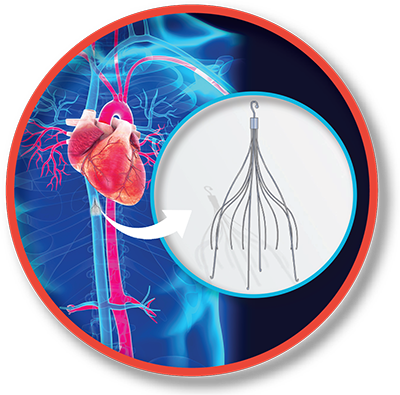OVERVIEW
The inferior vena cava (IVC) is the largest vein in the human body and carries deoxygenated blood from the legs, abdomen, and pelvis to the right atrium of the heart. When clot (deep venous thrombosis or DVT) forms in the legs and pelvis it is at risk for breaking off and traveling to the heart and lungs, an event known as a pulmonary embolism.
During an inferior vena cava filter placement procedure, a doctor will use real-time x-ray guidance to strategically place a filter in the inferior vena cava. The IVC filter is a cone shaped device that is designed to trap large clot fragments and prevent them from traveling through the vena cava to the heart and lungs where they could cause further complications or even death.
IVC filters were available only as permanent implants until recently. Newer filters called optional filters may be left in place permanently or have the option to be removed later.

FILTER INSERTION
A delivery catheter is inserted through the skin, using image guidance, and into a large vein in either the neck or the upper leg and moved to the inferior vena cava in the abdomen. The IVC filter is placed through the catheter and positioned in the inferior vena cava. Once in place, the doctor will release the filter, allowing it to expand fully and attach itself to the walls of the blood vessel.
FILTER REMOVAL
The filter may be removed when the patient is no longer at risk for a pulmonary embolism. This is most commonly determined when the patient’s lower extremity clot has resolved or the patient is adequately anti-coagulated. To remove an IVC filter, a special catheter is inserted into a large vein at the neck and moved to the site of the filter in the vena cava. A removable IVC filter contains a small hook or knob at one end of the filter that allows the catheter to capture the filter, close it, pull it into the catheter, and withdraw it from the body.
Removal of an IVC filter eliminates the long-term risks of having the filter in place. Although uncommon, filters can migrate (potentially into the heart), fracture with pieces of the filter injuring adjacent tissue, and develop clot themselves. In general, removal of a filter is a low-risk outpatient procedure and is recommended for patients when the filter is no longer required. It should be remembered that filters themselves do not address the cause of the deep vein thrombosis or abnormal coagulation. Also, not all retrievable IVC filters can be retrieved and for some patients, a permanent filter is beneficial.
Our providers are nationally recognized experts in minimally invasive procedures for placement and removal of IVC filters.
We provide IVC placement and removal throughout Western, MA and Northern, CT.
To learn more about treatments available at New England Endovascular Center call 413-693-2852 to make an appointment.
